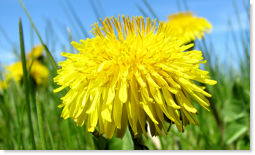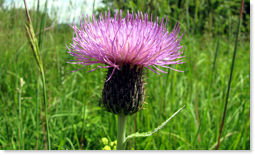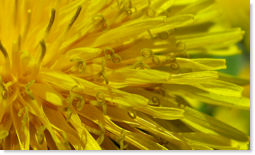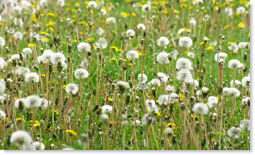
Biology of Dandelions |
By Johnny Caryopsis | (Click thumbnails for more images.) |
Name Derivation
OK, let's get one of the most pressing aspects of Dandelion biology out of the way first, their name. "Dandelion" is an English corruption of the French name for this plant: "dent de lion" meaning "lion's tooth", a reference to the tooth-like serrations on the plant's leaves. It was known as lion's tooth in other Latin based languages in Europe, too, so the English corruption may have evolved separately numerous times.
It's scientific name is Taraxacum officinale. The Genus name "Taraxacum" is thought to have been derived from a Persian word for the plant: "tarashaquq". It was recognized and used by Persian pharmacists around 900 A.D. (Thanks, Wikipedia.) The species name "officinale" derives from the Latin "officina", an office, store-room or pharmacy. Dandelion is recognized for a number of medicinal properties (see below).
Description
The Dandelion is an herbaceous perennial growing from a thick, unbranching tap root. The deeply toothed leaves are basal, meaning they don't grow up on stems, but emerge from the crown of the plant at ground level. The bright yellow flowers (do you really need a description?) grow on hollow stalks that may hug the ground or reach as high as 70 cm. The flower head is actually a tightly packed mass of many tiny florets (individual flowers), typical of the entire family of plants, the Asteracea. Each petal represents a single flower. The plants have a milky latex that oozes out if leaves or stems are broken.
Origin
Dandelions are native to Eurasia, but have been introduced to North America, South America, India (where it hadn't reached naturally), Australia, New Zealand and probably anywhere else where Europeans, the people, have migrated. It's thought that the introduction of this species to North America was intentional, as people wanted a flower that reminded them of their old homes, and as it was used medicinally. Once out of the bottle, though, the genie proved uncontrollable.
|
Dandelion Relatives
The evil Eurasian Dandelion has lots of close cousins around the world, which often closely resemble it, which is bad for the native varieties, as they get lumped in with and sometimes persecuted along with "Dandelions, the weed". For example, in North America there are various species of False Dandelion (Agoseris spp.) whose flowers look like classic Dandelion flowers, but which have quite different leaves. The rounded, compact, multifloreted, yellow flower is actually pretty standard as far as plants in the Cichoriaceae (a taxonomic tribe) go.
Life Cycle
Dandelions grow from seeds and do not spread asexually from stolons or runner; they have a single tap root. However, they can and do reproduce asexually by seed. They are capable of producing viable seed without need of cross-fertilization, a process known as "apomixis". The resulting progeny, also capable of apomixis, are basically clones of the parent plant. Most of the seed production in Dandelions is due to this process. In other words, how many Dandelions does it take to cover your entire lawn? Only one, given a little time.
Dandelions tend to flower most abundantly in spring, but can re-flower in the fall, too. Flowers open in the morning and tend to close up at night. After a couple of days in flower they close and the seeds develop inside the closed head. The seeds, technically a fruit called a "cypselae" are produced on the flower stalk with each seed representing one of the florets in the flower head. Each has a pappus, a set of feathery bristles that act as a sail or parachute ensuring distribution of the seed by the wind. (What kid doesn't know that?) As the seeds mature the flower stalk elongates greatly, raising the fluffy seed head up into the breeze.
When a seed germinates it produces a rosette of tiny leaves close to the ground surface and concentrates on growing a deep tap root. By the time you see a dandelion plant it is well established, which is why it seems you can never get rid of all the Dandelions in your lawn. There's always a new generation in the waiting. Individual plants can grow for 5-10 years and reach a considerable size, up to 50 cm across. (Just check out the ones behind your neighbour's garage!)
As Food and Drink
Did you know you can make wine out of Dandelions? There are lots of recipes for making Dandelion wine on-line. Or that the young leaves go great in salads? In fact, the family of plants that the Dandelion belongs to also includes lettuce! If you let a lettuce plant go to flower in your garden you'll see what I mean. And the roots of dandelions can serve as a coffee substitute when baked and ground. (Hint: if you are a real coffee aficionado, don't try this.) Hey, when life gives you lemons, make lemonade, or in this case if you have a yard full of Dandelions eat'em and drink'em. Apparently, you can make green and yellow dyes from the flowers, too.
Medicinal Use
The root of Dandelion is said to be diuretic (makes you pee). Some of its other common names suggest this quality: Pee-a-bed and Wet-a-bed. It is also reported to be a mild laxative, and the milky latex has been used as mosquito repellent. As always, use caution when using any plant for medicinal purposes. Read up on their properties and possible interactions with drugs or other medications.
Controlling Dandelions
As anyone with a lawn knows, Dandelions are prodigious plants, producing copious amounts of seeds which blow into your yard from your neighbours' yards. (You know, the lazy guy on one side who won't bother with his yard and the nature-nut on the other side who thinks Dandelions are "cool". Why can't everybody be like you.) If you're bent on getting rid of Dandelions in your lawn, here's a few tips:
- Don't cut your grass so short! Never cut grass shorter than 5 cm and don't cut more than 1/3 of the blade length at a time. When you scalp your grass you let more light in for Dandelions to grow!
- Don't use fertilizers! Dandelions and other weeds are better at sucking up fertilizers than the grass! Encourage plants like clovers to grow in the lawn providing natural sources of nitrogen fertilizer.
- When using a weed poker carry a cold beer in the other hand, make weeding more enjoyable!
If you really hate "the environment" then go ahead and use chemicals to control Dandelions, just do it properly! Weed killers containing 2,4-D work well on Dandelions. But the best time to use them is in the fall when the plants are transferring resources into their roots in preparation for winter. A fall herbicide application may not seem to be doing much visually at first, but come spring the effects will be far superior to a spring or summer application. If you're going to use 2,4-D read this article first: 2,4-Dichlorophenoxyacetic acid.
Biological Control
Why not biological control? Isn't there some little bug or disease in Eurasia that we could transplant to North America to go to work on our dandelions? Unfortunately, no one has yet to come up with any magic bullet for Dandelions. One of the main factors limiting work on biological controls is the fear of releasing yet another alien invasive into the North American ecosystem. People are so worried about releasing something that might have unforeseen consequences that they place huge road-blocks to doing so, to the extent that biological controls researchers are largely ham-strung.
A fungus, Sclerotinia minor, has shown some efficacy in controlling Dandelions, both by itself and with lower, sub-lethal doses of 2,4-D, but it's still a long way from becoming a truly effective bio-heribicide. (Bad News for Dandelions)
Some researchers have suggested that Dandelions are poor competitors for potassium. Limiting potassium in fertilizer regimes may help weaken Dandelions. (Biological Weed Control via Nutrient Competition: Potassium Limitation of Dandelions)
Economic Consequences
What is the cost to our society due to Dandelions? Unfortunately, I couldn't find an up-to-date accounting. Some older sources quote figures for the costs related to residential weed control; that includes more than just Dandelions, but that species is the single most important residential weed. Numbers in the BILLIONS of dollars are thrown around! Do Dandelions have much impact on agricultural weed control? Well, they're not among the worst agricultural pests, but they can be a problem. And how much do farmers spend on herbicides? BILLIONS and BILLIONS.
Final Thoughts
The war on dandelions is a war we cannot win. These plants are here to stay. By developing more environmentally sound lawn and yard care practices we can limit the populations of Dandelions somewhat, but face it, they are now a part of our landscape. And remember, it's just a little plant, it's not the second coming of Satan. Take a deep breath, relax and enjoy your lawn more. Life's too short to get all bent out of shape by a little plant.
If you liked this NatureNorth.com article you may also be interested in: |
|
| Our Prairie Crocus | Three-flowered Avens |
| Versatile Violets | Pink Lady's Slipper |
Thanks for learning about Dandelions! Bye for now!
| You can help NatureNorth produce more great articles with a secure donation through PayPal. Our Google Adsense ads pay our server costs, but that's about it. To learn more follow this link: Support NatureNorth. Thank-you! | |
Return to: Summer Issue | NatureNorth Front page




